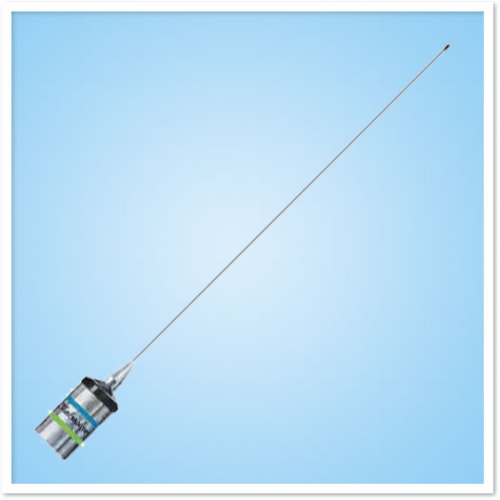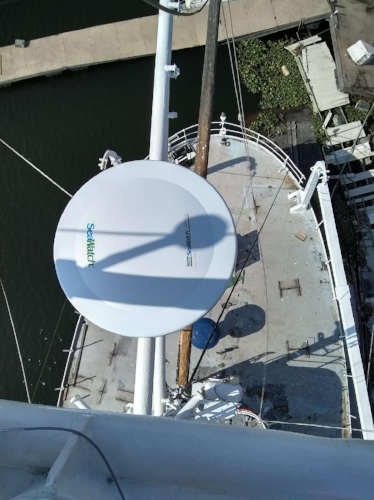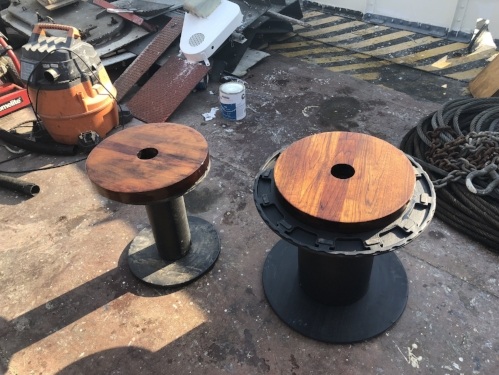Aft Mast
Work on the aft mast has lagged for several reasons. First, it is a difficult climb. The A-frame in the front has a conventional ladder and there is a crows nest where you can stand. I have a terrible fear of heights but I can muster the courage to climb the A-Frame. The aft mast is similar to climbing a telephone pole, and there is no comfortable place to stand. Furthermore, in order to work you have to trust a lanyard (in other words, let go with your hands and trust that the climbing harness will prevent you from falling to your certain death or quadriplegia). On our team, only Joe and Leo trust the lanyard. Chris claims that he isn't afraid of falling, it’s landing that terrifies him. My fear of heights makes me completely irrational at the sight of the aft mast.
Leo perched on the aft mast. His paint bucket hangs below. He is using an extension and 3 inch roller to paint the yardarms.
The other time consuming part of dealing with the aft mast is that the surfaces have to be cleaned every time we turn to this project (i.e. between every coat of paint). The blueberry fields are about 100 yards from the Fir. Birds feast on berries then sit on the guy wires at the top of both masts and crap all over the boat. So, every time we work on the mast, we begin by pressure washing. Getting the pressure washer set up to spray 56 feet above the waterline takes a couple of hours.
Getting the aft mast in shape is important for several reasons. At a bare minimum, masthead and anchor lights must be in place to USCG specifications (we are subject to the 50 meter rules which require two masthead lights and two anchor lights (more on this later). We also want to install several signal lights that we foresee will be required in situations consistent with our intended use. In addition, we want to mount the correct USCG lighting sequence to indicate that our movements are "restricted." We anticipate operating in areas where we are draft restricted (unable to significantly change course due to our draft). In addition, there will be instances when no licensed pilot is onboard. The USCG light sequence to indicate these conditions is generally red, white, red (more on this later). We have decided to utilize McDermott LED navigational lights.
The aft mast will be used for several antennas. The most important is the antenna for our last resort VHF radio. We have redundant VHF radios in the wheelhouse. The VHF antenna off the aft mast will be a completely separate system. We then have several media antennas. These antennas are important as a second source for weather information and internet access. However, these are primarily our entertainment antennas.
Early on, we decided on a few rules including: 1) let’s not do anything too stupid, and 2) let’s not waste money by doing things twice. With these thoughts in mind, we decided to fully prepare and paint the aft mast before installing the lights and antennas. We began by pressure washing the mast with our most aggressive turbo head. We then used muriatic acid to treat the rust spots and followed with a treatment of PPG Duraprep 88 and washdown. We touched-up rust spots, nooks, and crannies with PPG Amerlock Sealer followed by two coats of Amerlock 2/400 Light Tint Base. We finished with two coats of PPG PSX700 Light Tint Base. Due to birds love of the neighboring blueberry field as well as the Fir, a lot of time was spent cleaning between each coat.
Antennas
One of our first decisions was to select Shakespeare as our "go to" antenna supplier. Shakespeare manufactures all the antennas that we require (except the satellite TV antenna). They have a fantastic line of commercial and military grade antennas. We wanted to work with one manufacturer in-order to have easily compatible set of connectors and mounts. In addition, a single source is much easier for troubleshooting.
Shakespeare 5241-R Classic antenna.
We chose the Shakespeare 5241 as our holly s--t backup VHF antenna. We have redundant VHF radios in the wheelhouse that connect to separate Shakespeare antennas. These are high gain, 9 dB antennas that ought to be the best fit for Fir and our needs. In certain circumstances (e.g. heavy roll and extreme heeling) where lower gain antennas perform better, we chose a 3 dB antenna for our VHF radio of last resort. It is mounted 56 feet above the water line which gives us excellent line of sight.
The Shakespeare XXX installed. Note the blueberry fields to the lower right of the photograph.
We chose the Shakespeare XXX to extend our cellular range. From a price/speed perspective, cellular connectivity fits between WIFI and satellite alternatives. This system is essentially a cellular repeater. It grabs the cellular signal from a prime location (56 feet above the water line in our situation), amplifies the signal, then rebroadcasts the signal inside our boat. This should improve reception for all cellular devices. Of course, the most important use is our cellular modem that provides internet access for one of our navigation systems.
The Shakespeare Seawatch antenna installed on the yardarm. Note the wooden yardarm below. How are we going to refinish that?
We chose the Shakespeare XXX system for over the air television. Over the air television is an antiquated idea in most of the US. But, it is still available in most US costal markets. And, it is available in nearly every lesser developed market.
The Shakespeare XXX installed. The farm in the background is owned by Paris Hilton's grandfather.
Spotlights
Fir was originally equipped with two 115 volts AC spotlights. They were mounted to the top of the wheelhouse with two wooden bases. Over the years the wood bases were covered with some type of bute roofing material. Even with this treatment, the wood eventually rotted to the point where there was a leak in the wheelhouse and the mechanical system wobbled. We looked at a plastic replacement that would last forever. but Chis suggested that we use some teak from Aurora. Aurora had 2X6 teak rails and decking, so we harvested a small portion of what Chris had to offer. After pulling nails and chipping off glue we managed to salvage eight pieces about 30 inches in length. The pieces were joined together, cut into disks, and planned flat.
Our spotlight bases after their first coat of Nautipoxy.
One spotlight base after the first coat of Nautithane.
Cultural Diversion
Several members of our painting crew (Leo, Poochy, Harold, and Edward) are Native Americans. One reason that they may not be available for work is that they have Pow Wow. Most days, I go to sleep shortly after the workers leave. I am beat from the 100 degree heat and there is no AC on Fir. Further, I am generally on East Coast time. But, this trip I decided to check out the Pow Wow.
An "Indian Taco" served at Pow Wow. Basically, this is a grilled flatbread covered with seasoned meat, cheese, lettuce, and tomato.
Paint
We are getting to the end of our external painting. This is not to suggest that everything is perfect. But, all the metal (except for the deck) is properly protected from the elements. And, we have final quality paint on most of the boat. There are many small spots that will need attention. One reason that we chose the PPG line of industrial paints is that the PSX700 can be patched without leaving an obvious spot -- additional coats "melt" into the previous coats.
First time for a PPG mixing error. Note the color red before and after the bracket for the life vest container. We only had one gallon of red on hand so this effectively stopped us from finishing the detailed painting this trip.
Tender
Ouch!
Our safety record for this project has been good. Everyone has had the displeasure of bumping their heads on a steel beam (Fir is very unforgiving in this respect) and the dock has caused some falls (I went fully in the drink twice over the winter) but that has been about it. One reason is that we have the right climbing gear for work on the masts. The other reason is that the main generators are usually off when workers are on board. So, there is not much chance of electrical shock or injury from a crane, winch, or pump getting turned on inadvertently. We power most of the tools with extension cords and small generators kept on the buoy deck.
This trip I was rushing to pull an extension cord from the buoy deck to the engine room to fire up the internal potable water pump. When I descended the auxillary engine room stairs, the extension cord must have dislodged an old toolbox sitting on a shelf over the stairs. The tool box fell on my head and nearly knocked me out. When I regained my senses, I had a bloody head wound and a sprained ankle. Nothing serious. But, it reminded me that everything on a boat should be strapped in place even if you are sitting in a calm delta.









